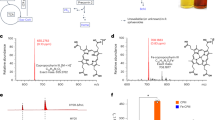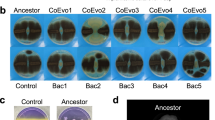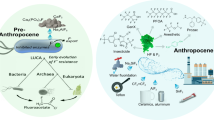Abstract
ACCORDING to Woolley1, chloramphenicol inhibits the utilization of phenylalanine in E. coli, due to its structural resemblance to that amino-acid. Truhaut, Lambin and Boyer2, on the other hand, have concluded from experiments with E. typhi that the antibiotic interferes in the early stages of the synthesis of tryptophane, which Fildes3 has formulated as follows:  In an attempt to elucidate the mode of action of chloramphenicol, its effect on E. coli, wild type, and on a number of its mutants, has been investigated. The inhibition caused in E. coli, wild type, can be fully reversed by indole and DL-tryptophane, less easily by DL-phenylalanine and L-tyrosine; it is not reversed by anthranilic acid. This result tends to show that chloramphenicol interferes with the synthesis of indole from anthranilic acid. The study of the mutants of E. coli clarifies the point still further.
In an attempt to elucidate the mode of action of chloramphenicol, its effect on E. coli, wild type, and on a number of its mutants, has been investigated. The inhibition caused in E. coli, wild type, can be fully reversed by indole and DL-tryptophane, less easily by DL-phenylalanine and L-tyrosine; it is not reversed by anthranilic acid. This result tends to show that chloramphenicol interferes with the synthesis of indole from anthranilic acid. The study of the mutants of E. coli clarifies the point still further.
This is a preview of subscription content, access via your institution
Access options
Subscribe to this journal
Receive 51 print issues and online access
$199.00 per year
only $3.90 per issue
Buy this article
- Purchase on Springer Link
- Instant access to full article PDF
Prices may be subject to local taxes which are calculated during checkout
Similar content being viewed by others
References
Woolley, D. W., J. Biol. Chem., 185, 293 (1950).
Truhaut, R., Lambin, S., and Boyer, M., Bull. Soc. Chim. Biol., 33, 387 (1951).
Fildes, P., Brit. J. Exp. Path., 21, 315 (1940); 22, 293 (1941); 26, 416 (1945).
Bergmann, E. D., Volcani, B. E., and Sicher, S., (unpublished results).
Ben-Ishai, R., Volcani, B. E., and Bergmann, E. D., Arch. Biochem. Biophys., 32, 229 (1951). Bergmann, E. D., Ben-Ishai, R., and Volcani, B. E., J. Biol. Chem., 194, 531 (1952).
Knox, W. E., and Mehler, A. H., J. Biol. Chem., 187, 419, 431 (1950).
Ben-Ishai, R., Volcani, B. E., and Bergmann, E. D., Experientia, 7, 63 (1951). Bergmann, E. D., Volcani, B. E., and Ben-Ishai, R., J. Biol. Chem., 194, 521 (1952).
Brown, S. A., and Byerrum, R. U., J. Amer. Chem. Soc., 74, 1523 (1952).
Ablondi, F., Gordon, S., Morton, jun., S., and Williams, J. H., J. Org. Chem., 17, 14 (1952), and following papers.
Yunusow, S., and Abutakirov, N. K., Chem. Abstr., 46, 516 (1952).
Author information
Authors and Affiliations
Rights and permissions
About this article
Cite this article
BERGMANN, E., SICHER, S. Mode of Action of Chloramphenicol. Nature 170, 931–932 (1952). https://doi.org/10.1038/170931a0
Issue Date:
DOI: https://doi.org/10.1038/170931a0
Comments
By submitting a comment you agree to abide by our Terms and Community Guidelines. If you find something abusive or that does not comply with our terms or guidelines please flag it as inappropriate.



